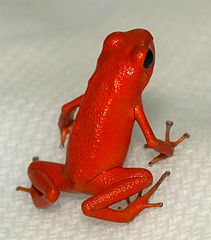Since their arrival in the US in the early 1980’s, White’s treefrogs (Litoria caerulea) have become one of the most popularly kept of all frogs. Although longevities of 25 years are known, captive breeding remains surprisingly uncommon. The white-lipped treefrog (Litoria infrafrenata), a large, attractive relative, is also infrequently bred by hobbyists. Considering how little we know about amphibian reproduction, and the precarious state of many species, I suggest that interested frog-keepers hone their breeding skills on the relatively robust White’s treefrog.
Distinguishing the Sexes
White’s treefrogs reach sexual maturity by age 2. Mature males are smaller than females, have loose, slightly dark skin about their throats and, when in breeding condition, sport thickened nuptial pads (used to grasp females during amplexus) on their thumbs. Only the males call.
The Dormancy Period
A cooling off period, preferably in late winter, is critical to breeding success. Cease feeding the frogs 7-10 days prior to the cooling period and place them into an aquarium furnished with a substrate of moist sphagnum moss and cork bark shelters.
 Gradually reduce the temperature to 65 F during the night (a basement is ideal) and 68 F during the day (use a small incandescent bulb to raise the temperature) and maintain this schedule for 4 weeks. Thereafter, hold the temperature at 65 F round-the-clock for an additional 2 weeks. The terrarium should be kept in the dark throughout this time, and the frogs should not be fed.
Gradually reduce the temperature to 65 F during the night (a basement is ideal) and 68 F during the day (use a small incandescent bulb to raise the temperature) and maintain this schedule for 4 weeks. Thereafter, hold the temperature at 65 F round-the-clock for an additional 2 weeks. The terrarium should be kept in the dark throughout this time, and the frogs should not be fed.
Preparing the Frogs for Breeding
After the 6 week “winter”, warm the frogs to 80 F over a 2 week period, and feed them heavily for 3-4 weeks. Novel prey animals, such as wild-caught or canned insects, should be offered at this time.
Thereafter, move the frogs into an aquarium filled with 4 inches water and provisioned with live floating plants (i.e. water hyacinth, water lettuce, pothos) and basking platforms. Use an aquarium heater to warm the water to 82-85F, and add a florescent bulb to encourage plant and algae growth. I recommend the Reptisun 2.0 bulb, as its UVB output is ideal for amphibians and plants…avoid strong reptile UVB bulbs.
Using a small submersible water pump, create artificial rain by pumping water into a perforated plastic container or PVC tube placed on the terrarium’s screen cover. Allow the “rain” to fall for 6-8 hours nightly, beginning at dusk. This step is vital in inducing spawning, and will usually result in reproduction within a week or so.
The Eggs
If all goes well, you will one morning find yourself in possession of thousands of eggs. It is wise to plan ahead and arrange for friends or nature centers to take some of the eggs, as crowded conditions can cause the loss of the entire clutch. Remove the adults and install an air pump driven sponge filter that provides mild water circulation.
In contrast to what is commonly recommended for some other frogs, I suggest raising White’s treefrog tadpoles in plant and algae filled aquariums as opposed to bare, sterile containers. I have even added green pond water to several tanks with good results.
Further Reading
You can read about White’s treefrog breeding in the wild, and hear recordings of the males’ calls, at http://magneticisland.s4space.com.au/L.caerulea.html.
 That Reptile Blog – Reptile, Amphibian and Exotic Pet Care and Information
That Reptile Blog – Reptile, Amphibian and Exotic Pet Care and Information


